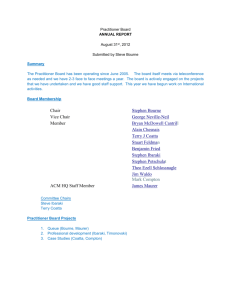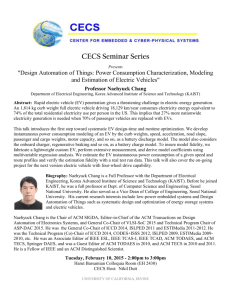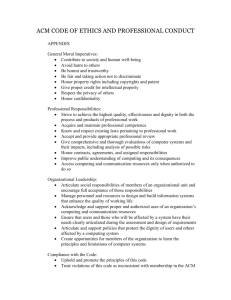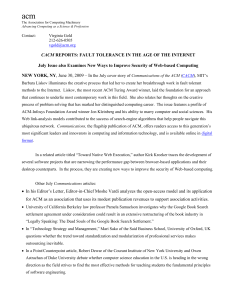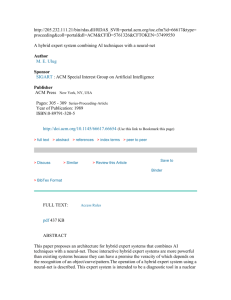Professions Board
advertisement
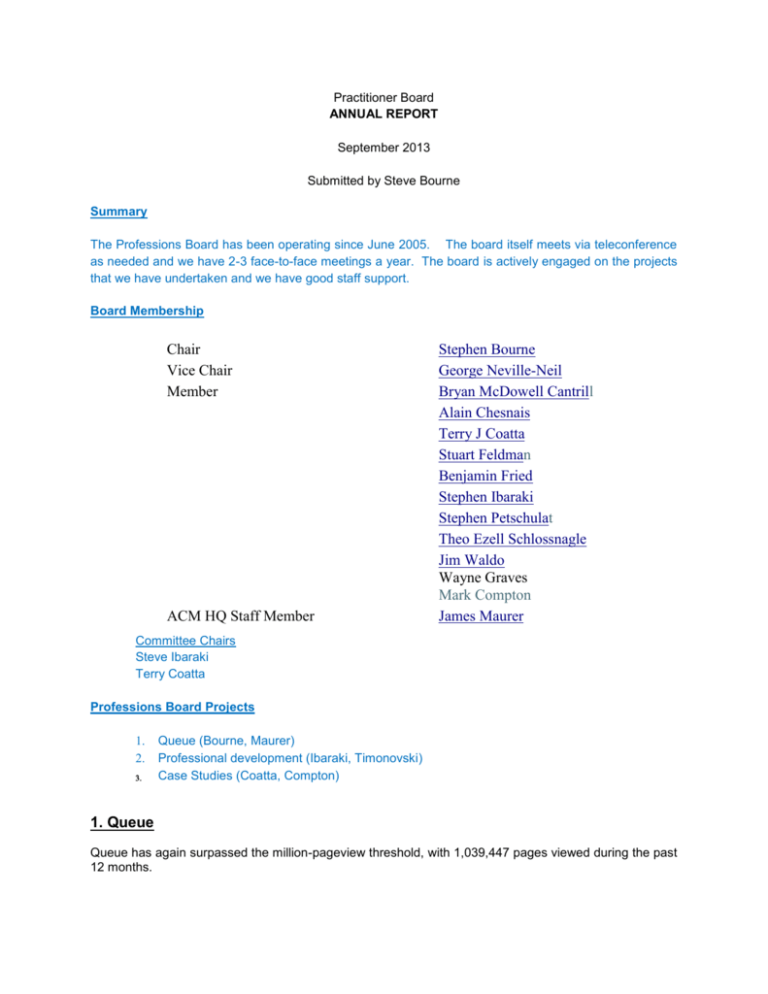
Practitioner Board ANNUAL REPORT September 2013 Submitted by Steve Bourne Summary The Professions Board has been operating since June 2005. The board itself meets via teleconference as needed and we have 2-3 face-to-face meetings a year. The board is actively engaged on the projects that we have undertaken and we have good staff support. Board Membership Chair Vice Chair Member ACM HQ Staff Member Stephen Bourne George Neville-Neil Bryan McDowell Cantrill Alain Chesnais Terry J Coatta Stuart Feldman Benjamin Fried Stephen Ibaraki Stephen Petschulat Theo Ezell Schlossnagle Jim Waldo Wayne Graves Mark Compton James Maurer Committee Chairs Steve Ibaraki Terry Coatta Professions Board Projects Queue (Bourne, Maurer) Professional development (Ibaraki, Timonovski) Case Studies (Coatta, Compton) 1. Queue Queue has again surpassed the million-pageview threshold, with 1,039,447 pages viewed during the past 12 months. The site has had an increase in visitors of 1.24% and an increase of 2.84% for visits from users who are new to the site. --Queue has been getting more attention through “social media” sites Reddit is currently the biggest referring site by volume (after several years of Slashdot having this distinction, and often swapping the title of ‘biggest referrer’ with Hacker News) and it is driving 24.15% more visitors to Queue than last year. The following 5 articles got the most traffic from Reddit “XML Fever” Erik Wilde, October 2008 “Weathering the Unexpected” Kripa Krishnan, September 2012 “There's Just No Getting around It: You're Building a Distributed System” Mark Cavage, April 2013 “Nonblocking Algorithms and Scalable Multicore Programming” Samy Al Bahra, May 2013 “Anatomy of a Solid-state Drive” Michael Cornwell, October 2012 (Note that the #1 article from the #1 referring site was written in 2008, showing the value of the evergrowing back-catalog of Queue articles in the ACM Digital Library.) Hacker News and Twitter have sent the same number of readers to Queue over the past 12 months. Twitter traffic is up 41.45% from last year. Other sites are also taking hold, with Google+ traffic up 358% and traffic from the Chinese search/blogging site Sina Weibo up 566.81%. The volume of traffic from these sites is low but the huge growth mirrors that of Twitter, which was a novelty site a few years ago, but is now an essential source of readers. Despite some effort on our part and despite its relevance elsewhere on the Web, Facebook remains a marginal source of readers, with fewer than 6,000 visits coming from Facebook over the past year. However, we should note that a lot of the Web2.0/HTML5/JQuery connections from Facebook and other modern sites make it difficult to count every interaction. --These were the most-read articles and columns over the past 12 months. UNIQUE VIEWS TITLE --------- --------32,065 Anatomy of a Solid-state Drive 29,623 A Tour through the Visualization Zoo 22,893 There's Just No Getting around It: You're Building a Distributed System 23,030 A File System All Its Own 22,279 Nonblocking Algorithms and Scalable Multicore Programming 20,229 FPGA Programming for the Masses 19,465 More Encryption Is Not the Solution 18,475 Weathering the Unexpected 17,615 You're Doing It Wrong 17,103 Splinternet Behind the Great Firewall of China 16,905 A Generation Lost in the Bazaar 13,603 Structured Deferral: Synchronization via Procrastination 12,947 12,997 12,832 11,126 11,198 10,166 10,455 Thinking Methodically about Performance NUMA (Non-Uniform Memory Access): An Overview Realtime Computer Vision with OpenCV The Antifragile Organization Rethinking Passwords BASE: An Acid Alternative BufferBloat: What's Wrong with the Internet? About half of these are from the past year and the other half from 1 or more years ago. Queue has begun creating and publishing Queue Video Portraits, which are interviews with young practitioners who are ACM members. We have published 5 so far this year and the results seem promising. Practitioner Digest The practitioner digest aims to bring content from the Digital Library to practitioners through a curation process. Eric Allman is leading this effort with help from Alain Chennais, Shriram Krishnamurthi, and George Neville-Neil. The areas currently being curated are Graphics, Programming Languages and Networking. The first edition is ready to be collected into a publishable and awaits a decision on how it will be published, whether as a paper journal or as an online collection. 2. Professional Development Committee Professional Development Committee (PDC) – Ibaraki/Timanovsky * - New for 2013 Stephen Ibaraki (Chair), David A. Black, Stephen Bourne, Netiva Caftori, Robert Y. Chu, Terry J. Coatta, Michelle Cross, Don Gotterbarn*, Bradley Jensen, Terence W. Linkletter, Joyce Currie Little, Srikantan (Tan) Moorthy, William H. Tetzlaff, Will Tracz, Yan Timanovsky (ACM HQ) Webinar subcommittee (PDC-W): Will Tracz (Principal/lead contributor), Stephen Ibaraki, Tan Moorthy, Scott Delman (ACM Director of Pubs/DL; advisor), Yan Timanovsky (ACM HQ) Professionalism and certification subcommittee (PDC-PCC): The PCC is charged with scanning the computing professionalism landscape for important new developments so ACM is prepared to act if necessary. Three members are also in the ICCP where the ACM is a founding member. It consists of: Don Gotterbarn* (ICCP board ACM rep), Stephen Ibaraki, Bradley Jensen, Terry Linkletter (ICCP contributor), Joyce Currie Little (ICCP board ACM rep), Tan Moorthy, Yan Timanovsky (ACM HQ) -------------------------------------In FY 2012-13, the ACM PDC continued building on the success of the previous year, notably increasing the frequency and reach of the webinar program and tighter integration of ACM assets such as the addition of Turing Centenary videos, Queue content and other ACM learning assets into the ACM Learning Center (LC: Hub of ACM learning ecosystem). Highlights: A. Webinar Program B. E-learning offerings (books, videos, courses) C. Tech Packs D. Podcasts E. Partnerships A. ACM Learning Webinars After a very successful 2012 launch, the model remains largely the same, with a few modifications: Monthly schedule; Greater participation from SIG community; Free to all (members & nonmembers), both live and on-demand (recording); After 1 month, recording moves to ACM YouTube channel (embedded in Learning Center) with access open to all, CC/some translation via YouTube widget; Monthly Learning Center (LC) Bulletin with LC highlights: 165K distribution; Social media integration (Twitter) for Questions; Post-event answers to questions from event. 6 webinars in FY 13; 10 total to date. Highlights: -April 2013 Future of the Internet, Vint Cerf & Stu Feldman; 3407 reg, 824 live; 628 on demand -May 2013: Engineering SaaS, Dave Patterson & Armando Fox; 3148 reg, 834 live; 579 on demand -June 2013: IBM Watson, Adam Lally & Will Tracz; 3819 reg, 1002 live; 764 on demand -July 2013: Parallel Computing (SIGHPC), Bill Gropp & John West; 4878 reg, 1397 live; 1060 on demand -August 2013: NELL (Machine Reading), Tom Mitchell & Yolanda Gil; 3180 reg, 856 live; 570 on demand B. E-Learning Offerings -150+ online books from Morgan Kaufmann & Syngress, available for all members; 700 Safari (professional); 500 Skillsoft (all members) -A new Safari app, developed in coordination with ACM, standalone, seamless mobile access -Switched from Element K to Skillsoft Courses. Courses will be integrated with (Skillsoft) Books 24x7 titles on the same platform with the next release of Skillport (tentatively scheduled for Q1 2014). Usage: 08/17/12-08/26/13: Safari, 9,956 active users; Books 24x7, 13,342; Skillsoft courses, 7,375. C. Tech Packs Live (updates in progress) Cloud Computing, Parallel Computing, Enterprise Architecture, Mobility, BI/Management, Security Tech Packs In Development: Big Data, Computing Ethics/Professionalism, AI: Machine Learning, Bioinformatics (with social media enhanced curation), Social Networking, Enterprise Architecture 2.0 D. Podcasts Over 60 Podcasts w/industry leaders (done by Stephen Ibaraki). Includes Mathai Joseph, Judea Pearl, Terry Coatta, Silvio Micali, Shafi Goldwasser, Jean Dean, Sanjay Ghemawat, Tado Saito, Robin Raskin, Alain Chesnais, James Maurer, Will Tracz, Gabriel Sliberman, Roy Want, TP & LP authors, etc. E. Partnerships In addition to existing partnerships with Stevens Institute of Technology and NYU ePoly (offering members discounts on online master’s and certificate tracks), ACM is finalizing a partnership with CompTIA that will offer discounts for members taking CompTIA certification exams (i.e. A+, Networking+, Security+, etc.): up to 20% for professional grade members and 40% off for student members. 3. Case Studies The Case Study Steering Committee currently consists of: • Terry Coatta (committee chair) • Mark Compton • Steve Bourne (ICON Ventures) • Jim Gettys (Alcatel-Lucent Bell Labs) • Jeremy Howard (Kaggle) • Becky Bace (Infidel, Inc.) • Harry Saal (founder, Network General) • Amer Diwan (Google) • Tom Limoncelli (Stack Exchange) • Meadhbh Hamrick (Mozilla) Two case studies were published over the course of the past year, and a third is currently well along in the development process. The first of these focused on Browser Security or, more accurately, the myths of browser security and the false hopes that have been pinned on HTML5. The participants in the discussion at the heart of that case study were Jeremiah Grossman (WhiteHat Security), Ben Livshits (Microsoft Research), Becky Bace (Infidel), and George Neville-Neil. A second case study that’s about to post on the Queue website considers JavaScript on the Server — specifically, the efforts at LinkedIn to rewrite all of the organization’s core mobile services in Node.js, with particular attention being given to the language evaluation process, code/design patterns, challenges related to working within an evented environment, and issues having to do with introducing typing/encapsulation abstractions to a dynamic language. The participants in the core discussion there included Kiran Prasad (who led the development effort at LinkedIn), Kelly Norton (one of the initial GWS developers at Google who’s recently gone off to launch his own company, Homebase.io), and Terry Coatta. A third case study that’s late in its production cycle considers the arguments for and against Automated QA Testing, focusing on difficulties encountered in the course of a move in that direction at Electronic Arts, leading to a decision to start experimenting with MVVM-like architectures. The discussion participants there include Michael Donat (EA), Jafar Husain (Netflix), and Terry Coatta. Three additional case studies are currently in the works. One looks at the efforts at Google to deploy a private WAN connecting all of the organization’s global data centers by way of a software-defined network. Another considers the development of Facebook’s Friend Recommendation System. The third, meanwhile, delves into the reasons that led DoubleClick to transition to an AngularJS-based system. In addition, the case study program managed to recruit and develop six articles to accompany these case studies. Each of the six articles has appeared in CACM as well as on the Queue website, and two have been Slashdotted.
